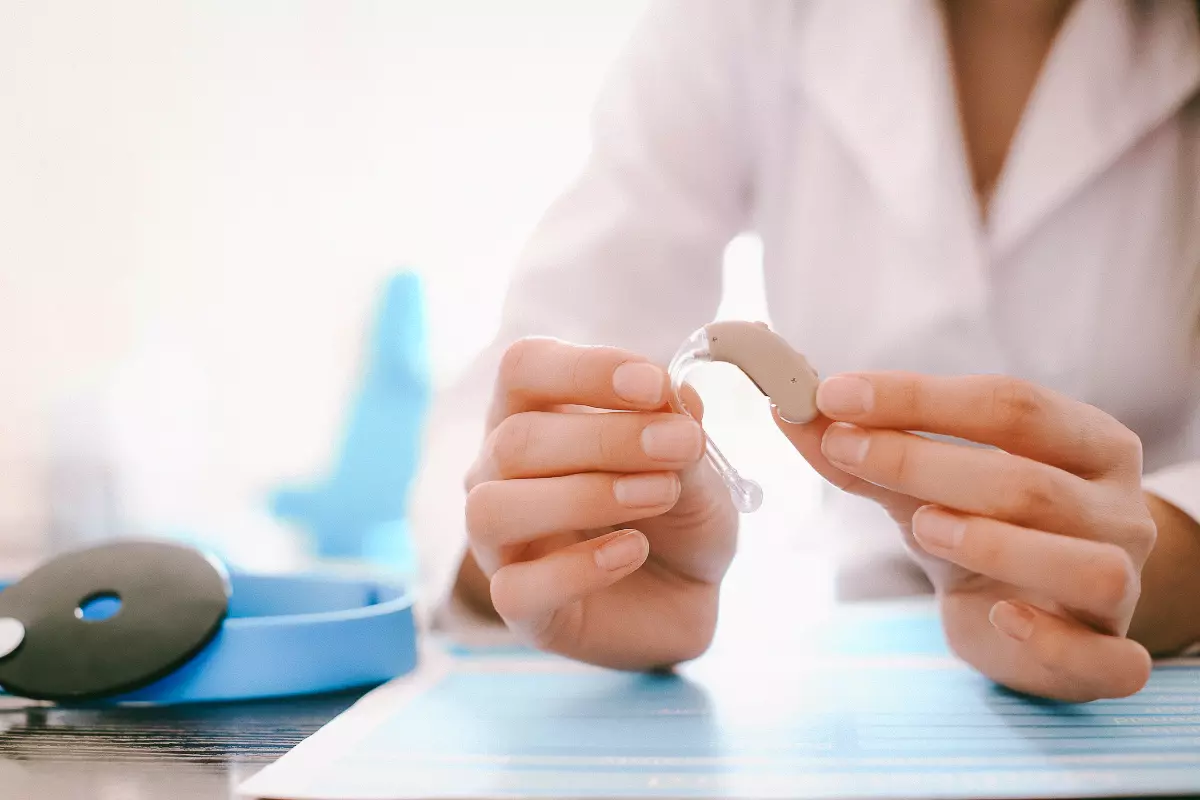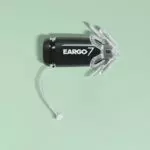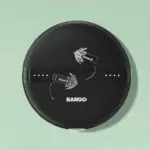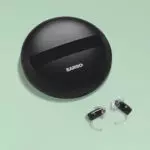Table of Contents
More than 40 million people in the United States have difficulty hearing, but only about 16 percent of those between the ages of 20–69 actually use hearing aids. Living with untreated hearing loss increases the risk of depression, anxiety, and social isolation, so overcoming the barriers that prevent hearing aid use can lead to improved mental health. Studies suggest that high prices, uncomfortable designs, and stigma surrounding hearing aids may be why people don’t want to wear them.
To address the issue of stigma, over-the-counter hearing aid company Eargo designed a tiny device that sits completely in the ear canal, making it a virtually invisible hearing aid to onlookers. If you’re one of the 89 percent of people who don’t want to publicly acknowledge their hearing loss, an Eargo hearing aid could be right for you.
Eargo currently sells three hearing aids that share the same design but feature increasingly advanced technology. We tested these models to compare their performance, comfort, and ease of use to other over-the-counter (OTC) and traditional hearing aids.
Below, we’ll explain our findings and outline the differences between each model so you can decide if an Eargo hearing aid is the best hearing aid for you.
Which Eargo hearing aid is right for you?
- Eargo 7: Most advanced features.
- Eargo 6: Best blend of features and price.
- Eargo 5: Most affordable.
- Eargo SE: Best hearing customizations for less.
- LINK by Eargo: Most affordable hearing aid with Bluetooth streaming.
HelpGuide Handbook for Eargo Hearing Aids
If you only learn five things about Eargo hearing aids, this is what you need to know:
Our testing experience




When the FDA approved OTC hearing aids in October 2022, the OTC hearing aid market experienced rapid growth with an influx of new companies. While this improves accessibility and helps drive down prices, it also muddies the waters. How do you know which products are trustworthy?
After surveying the market, interviewing hearing health experts, and speaking to real hearing aid users, we curated a list of 21 OTC models to test from nine brands: Audien, Audicus, Eargo, Go Hearing, Jabra Enhance, Lexie, Lucid, MDHearing, and Sony. We chose these brands because they have positive reputations and represent a range of prices, styles, and features.
We also tested prescription models from Oticon, Phonak, and Starkey to experience the difference between OTC and Rx (prescription) hearing aids firsthand.
The process looked like this:
Our testers tried multiple devices and answered 25 questions about each. We used these answers to look for outstanding performers and to compare models within each brand.
From our tester
“The Eargo 5, 6, and 7 are the same size and shape, which fits firmly in the ear and felt a little uncomfortable until I switched to the open petal tips.”
We also completed onboarding calls with brand audiologists and talked with customer service representatives over the phone and through chat modules to accurately replicate the buying process and evaluate post-purchase support options.
Finally, we wrapped up our testing by interviewing independent audiologists, hearing instrument specialists, mental health experts, and hearing aid users to get additional perspective on OTC hearing aids.
The case for OTC hearing aids is particularly compelling. Being able to reach a wider population by increasing accessibility, simplifying the ease of fitting, and reducing the cost barriers . . . opens the gateway to an array of possibilities [previously inaccessible] due to exorbitant costs and lack of insurance coverage.
Shelley Singh, a board-certified audiologist
Learn more about our hearing aid review methodology.
Pros and cons of Eargo hearing aids
What we like about Eargo
- Self-fitting.
- Free fit kit.
- Small design.
- 16-hour battery life.
- Customizable modes.
- Adjusts through app or ear tap.
- Automatic mode adjustments (Eargo 6 and 7).
- Lifetime audiology support through email, chat, and video calls.
What we don’t like about Eargo
- No telecoil.
- No low battery warnings.
- No directional microphones.
- Monthly maintenance can get pricey.
- Tapping the ear doesn’t change programs in both hearing aids simultaneously.
Eargo hearing aids reviews
Key features of Eargo hearing aids
Standard features
Here are the standard features you can expect from Eargo hearing aids:
Model-dependent features
- Water-resistant (IPX7 rating) vs. not water-resistant.
- Sweat-resistant vs. no sweat resistance.
- Automatic vs. manual mode adjustments.
- Sounds to confirm mode changes vs. no confirmation sounds.
- Two-year vs. one-year warranty.
How much do Eargo hearing aids cost?
Eargo hearing aids cost $799–$2,950. The average cost of OTC hearing aids hovers around $1,600. Here are some additional cost features of Eargo hearing aids:
- Shipping is free.
- Military members get a 20 percent discount.
- First responders and medical professionals get a 10 percent discount.
- Financing is available through Bread Pay™.
Eargo recommends changing the microphone caps, wax guards, and petals every month to ensure proper sound quality and comfort. If you follow this recommended schedule, expect to pay $80 every three months and another $25 every eight months for necessary supplies.
Medicare doesn’t cover the expense of hearing tests, hearing aids, or fittings. Medicaid only covers hearing aids in select circumstances for individuals on specific Medicaid plans. Because of this, mid-priced, over-the-counter hearing aids can be a great option for those with Medicare, Medicaid, or insurance with limited or no coverage of hearing aids.
How to use the Eargo app
When you open the Eargo app, you’ll automatically see the Volume screen. Here you can adjust the volume on each individual hearing aid or change both at the same time. There’s also a mute button.
Tapping Noise Filter at the top of the screen brings you to the background noise reduction menu. These changes always affect both hearing aids. High indicates a high level of noise reduction, whereas Low reduces background noise the least. You also have the option to turn off the background noise filter.
According to our survey
According to our survey, 43 percent of Eargo users say they use the mobile app often and it’s helpful and intuitive to use. Only the Jabra Enhance and Lexie apps scored higher.
Next, tap Programs. The Eargo hearing aids will cycle through the four programs you see on this main screen when you tap the side of your ear. You can easily swap out the active programs by following these steps:
- On the Programs screen, tap Edit.
- Select the program you want to remove.
- Tap Change program.
- Choose the program you want to add.
Here are the programs available in Eargo hearing aids:
- Normal.
- Restaurant.
- Meeting.
- TV.
- Phone.
- Music.
- Mask (Eargo 6 and Eargo 7).
- Four customizable slots.
You can adjust treble and bass tones within each program, but most of the tuning is automatically done for you based on your Sound Match hearing test results. You take this hearing test on the app when setting up your Eargo hearing aids and can retake it at any time.
From our tester
I couldn’t get the Eargo app to connect to the hearing aids to do the Sound Match test. A remote Eargo audiologist helped me get everything working and walked me through the features.
The Eargo app also lets you set maintenance reminders, view helpful resources, call customer support, or connect with hearing professionals.
Our final verdict
All five Eargo hearing aids accomplish what the brand set out to do: Make OTC hearing loss management virtually invisible. The devices’ tiny size presents a challenge, though, since there’s limited space for technology. That said, we think Eargo has done a good job focusing on the essentials, like rechargeable batteries and app connectivity.
If you are considering purchasing hearing aids, read our in-depth review of the best hearing aids on the market.
Frequently asked questions
Your Medicare Advantage plan (Medicare Part C) may cover the cost of hearing aids like Eargo, but Original Medicare (Part A and Part B) does not. Talk to your Medicare Part C provider to find out if your plan covers the cost of hearing aids like Eargo.
Eargo says its hearing aids last about three years before needing to be replaced.
Yes, LINK by Eargo has Bluetooth 5.3 music and phone streaming and an earbud-style design.
Yes, you can sleep while wearing Eargo hearing aids as long as you find it comfortable to do so. However, the 16-hour battery life in Eargo devices is just enough to get you through the day. Many people recharge them at night for best results.
- Over-the-counter (OTC) hearing aids Market Size, market share, application analysis, regional outlook, growth trends, key players, competitive strategies and forecasts – 2023 to 2031. Research and Markets. Link
- Jayakody, D. M., Wishart, J., Stegeman, I., Eikelboom, R., Moyle, T. C., Yiannos, J. M., Goodman-Simpson, J. J., & Almeida, O. P. (2022). Is there an association between untreated hearing loss and psychosocial outcomes? Frontiers in Aging Neuroscience, 14. Link
- Hearing aids may slow dementia onset. Johns Hopkins Bloomberg School of Public Health. (n.d.-a). Link
- Study: Many Americans are against their treatment of hearing loss. Hear the World Foundation. (2017, February 22). Link
- McCormack, A., & Fortnum, H. (2013). Why do people fitted with hearing aids not wear them? International Journal of Audiology, 52(5), 360–368. Link
- NHIS-Adult Summary Health Statistics. (2018, August 27). Centers for Disease Control and Prevention. Link
- U.S. Department of Health and Human Services. (n.d.). Quick statistics about hearing. National Institute of Deafness and Other Communication Disorders. Link
- Reed, N. S., Garcia-Morales, E., & Willink, A. (2021). Trends in hearing aid ownership among older adults in the United States from 2011 to 2018. JAMA Internal Medicine, 181(3), 383. Link













